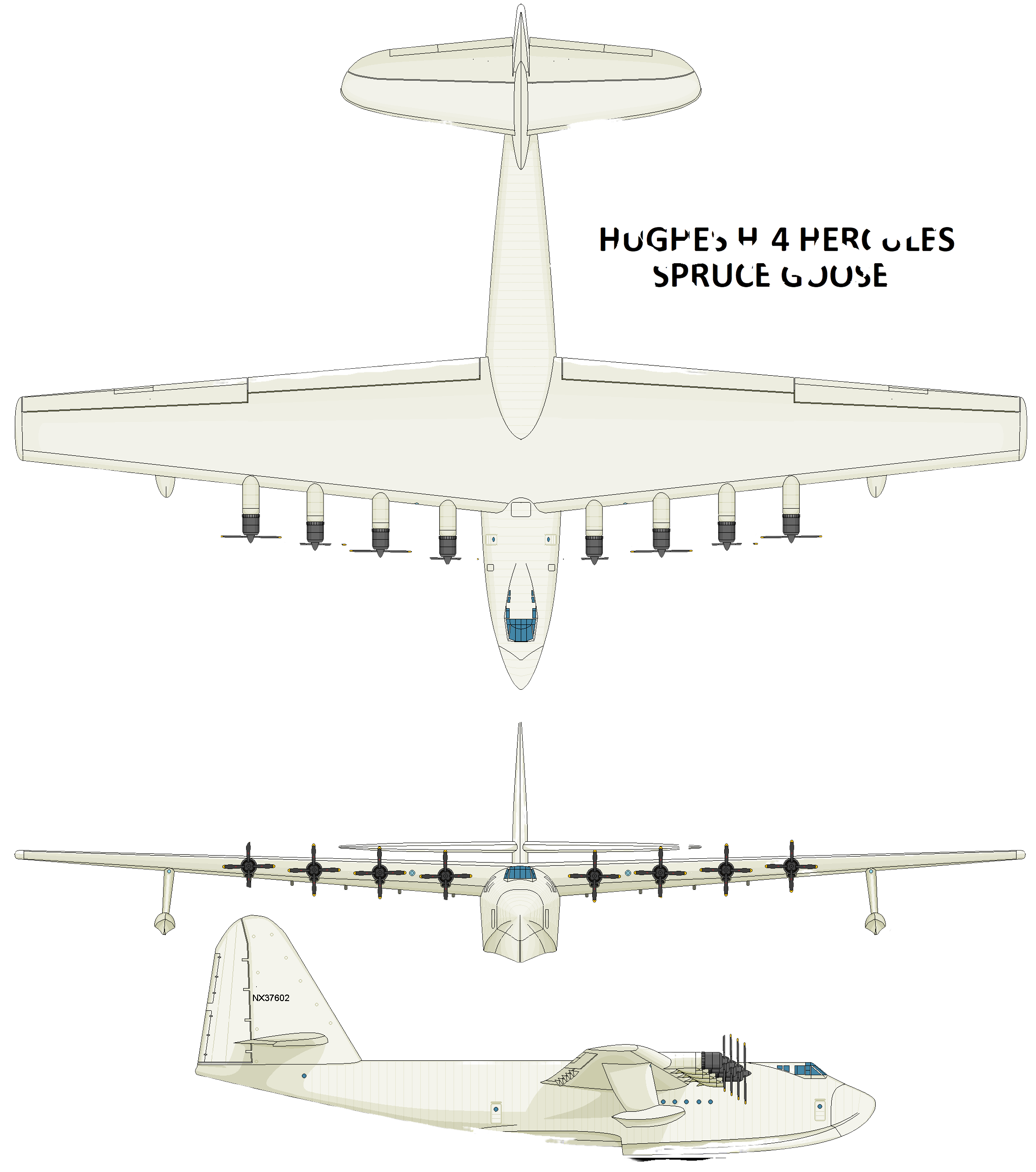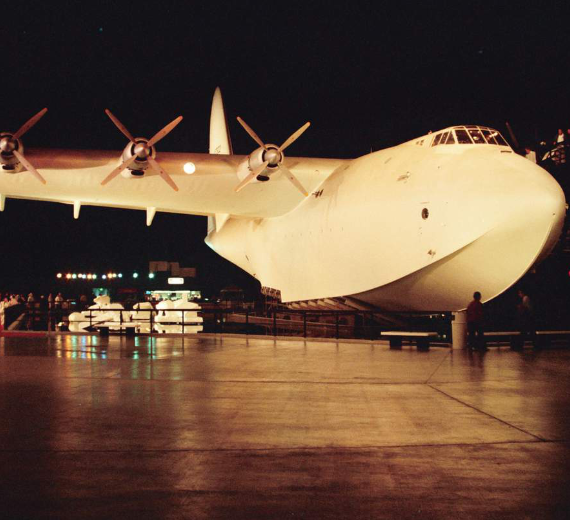Hughes H-4 Hercules Spruce Goose
 |
|
| General information | |
|---|---|
| Type | Heavy transport flying boat |
| National origin | United States |
| Manufacturer | Hughes Aircraft |
| Designer | Howard Hughes |
| Status | Preserved |
| Number built | 1 |
| History | |
| Manufactured | 1947 |
| Introduction date | 1947 |
| First flight | November 2, 1947 (77 years ago) |
| Preserved at | Evergreen Aviation & Space Museum |
| Fate | Preserved |
.
History Boeing
Hughes
H-4 Hercules Spruce Goose
Design and development

In 1942, the U.S. War Department needed to transport war materiel and personnel to Britain. Allied shipping in the Atlantic Ocean was suffering heavy losses to German U-boats, so a requirement was issued for an aircraft that could cross the Atlantic with a large payload. Wartime priorities meant the aircraft could not be made of strategic materials (e.g., aluminum).
The aircraft was the brainchild of Henry J. Kaiser, a leading Liberty ship builder and manufacturer. Kaiser teamed with aircraft designer Howard Hughes to create what would become the largest aircraft yet built. It was designed to carry 150,000 pounds (68,000 kg), 750 fully equipped troops or two 30-ton M4 Sherman tanks. The original designation "HK-1" reflected the Hughes and Kaiser collaboration.
The HK-1 aircraft contract was issued in 1942 as a development contract and called for three aircraft to be constructed in two years for the war effort. Seven configurations were considered, including twin-hull and single-hull designs with combinations of four, six, and eight wing-mounted engines. The final design chosen was a behemoth, eclipsing any large transport then built. It would be built mostly of wood to conserve metal (its elevators and rudder were fabric-covered), and was nicknamed the Spruce Goose (a name Hughes disliked) or the Flying Lumberyard.
While Kaiser had originated the "flying cargo ship" concept, he did not have an aeronautical background and deferred to Hughes and his designer, Glenn Odekirk. Development dragged on, which frustrated Kaiser, who blamed delays partly on restrictions placed for the acquisition of strategic materials such as aluminum, and partly on Hughes' insistence on "perfection." Construction of the first HK-1 took place 16 months after the receipt of the development contract. Kaiser then withdrew from the project.

0
KmCeiling
0
KmMAX RANGE
0
Km/HAircraft Speed
0
Max Crew
Photo Gallery
Hughes
H-4 Hercules Spruce Goose
The "Birch Bitch"


Hughes
H-4 Hercules Spruce Goose
The "Birch Bitch"
General characteristics
- Crew: 3
- Length: 218 ft 8 in (66.65 m)
- Wingspan: 319 ft 11 in (97.51 m)
- Height: 79 ft 4 in (24.18 m)
- Fuselage height: 30 ft (9.1 m)
Powerplant
- Empty weight: (113,398 kg)
- Powerplant: 8 × Pratt & Whitney R-4360 Wasp Major 28-cylinder air-cooled radial piston engines, 3,000 hp (2,200 kW) each
- Propellers: 4-bladed Hamilton Standard, 17 ft 2 in (5.23 m) diameter constant-speed propellers
- Powerplant:
Specifications
- Cruise speed: (400 km/h, 220 kn)
- Range: 3,000 mi (4,800 km, 2,600 nmi)
- Service ceiling: 20,900 ft (6,400 m)
Armament
-
- Blohm & Voss BV 238 (Large WW2 flying boat)
- Blohm & Voss P 200 (Large WW2 flying boat design)
- Latécoère 631 (Large airliner flying boat)
- Martin JRM Mars (Largest Allied flying boat to enter service in WW2)
- Saunders-Roe Princess (Post-war large airliner flying boat)
-
Links to Youtube & Others
Fittingly, the original design and concept of what would become
the H-4 was dreamed up by a shipbuilder, Henry J. Kaiser
Hughes
H-4 Hercules Spruce Goose
This is a brief history of the Hughes H-4 Hercules, known as the Spruce Goose.
Youtube Link
Fittingly, the original design and concept of what would become the H-4 was dreamed up by a shipbuilder, Henry J. Kaiser















.svg.png)